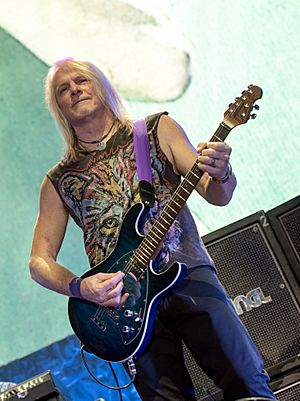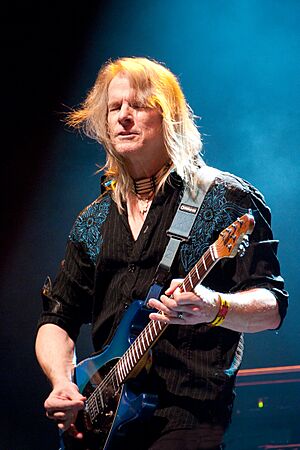Steve Morse facts for kids
Quick facts for kids
Steve Morse
|
|
|---|---|

Morse live with Deep Purple in Hamburg in 2017
|
|
| Background information | |
| Born | July 28, 1954 Hamilton, Ohio, U.S. |
| Genres | Instrumental rock, progressive rock, hard rock, heavy metal, jazz fusion |
| Occupation(s) | Musician |
| Instruments | Guitar |
| Years active | 1969–present |
| Associated acts | Dixie Dregs, Kansas, Deep Purple, Living Loud, Angelfire, Flying Colors |
Steve J. Morse, born on July 28, 1954, is a famous American guitarist and songwriter. He has been nominated for a Grammy Award seven times! Steve is most known for starting the band Dixie Dregs. He was also the guitarist for the legendary band Deep Purple for a very long time. Steve also had a successful career playing music by himself. He was a member of the band Kansas in the 1980s. More recently, Steve joined the supergroup Flying Colors.
Contents
Steve Morse's Early Life

Steve Morse was born in Hamilton, Ohio. His family moved to Tennessee and then to Ypsilanti, Michigan. Steve spent his childhood years there. He learned to play the piano and clarinet, but he eventually chose the guitar.
Steve played in a band called the Plague with his older brother Dave. Later, his family moved to Augusta, Georgia. In the late 1960s, he played in a band called Three. This band included his older brother and a friend from school, Jerry Wooten, who played keyboards. They performed at local clubs and church events.
Forming Early Bands
While in high school, Steve met bassist Andy West. They formed a band called the Dixie Grit. This group played songs by bands like Led Zeppelin and Cream. West and Morse continued to play as a duo called the Dixie Dregs. Steve was even kicked out of school for not cutting his hair!
Steve finished high school at a Catholic school. He then went to the University of Miami School of Music. Many famous musicians, like Pat Metheny, also studied there. Andy West joined Steve at the university. They formed a group called Rock Ensemble II. In 1975, they made a recording called The Great Spectacular.
After college, Steve worked as a co-pilot for an airline for a short time. Since 1991, he has lived in Ocala, Florida. He is also involved in hay farming there.
The Dixie Dregs Band
After Steve graduated from the University of Miami, he and Andy West officially named their band Dixie Dregs. A new drummer, Rod Morgenstein, joined them. The band started playing regularly. They played their own songs and music by other artists.
First Albums and Success
The band's busy schedule caught the attention of Capricorn Records. In late 1976, they signed with the record label. Their first album for Capricorn was Free Fall. This album showed that Steve was a talented new musician in the jazz fusion style. He wrote all 11 songs on the album. Even though it received good reviews, it did not sell many copies.
In 1978, they released What If. The band's sound grew to include southern rock, classical, folk, and country music. They toured to support the album, but sales were still low. However, they were invited to play at the Montreux Jazz Festival in Switzerland. Four songs from this show were released on their next album, Night of the Living Dregs.
Changing Labels and Names
In 1979, Arista Records signed the band. Steve took charge of producing their next album, Dregs of the Earth, released in 1980. All eight songs were written by Steve. This album reached number 27 on Billboard's Jazz Album Chart.
Arista Records wanted the band to sell more albums. They asked the band to change their name to just The Dregs. They hoped this would make the band more popular. The album Unsung Heroes came out in 1981. It had seven new songs by Steve. But the name change did not help album sales much. The record company then asked The Dregs to add singing to their next album, called Industry Standard.
Steve's songs on Industry Standard sounded more like his solo work. The album was praised by critics and fans. Industry Standard was voted "Best Guitar LP" by readers of Guitar Player magazine. Steve was also voted "Best Overall Guitarist" for five years in a row! This honor put him in their "Gallery of Greats." After finishing their contract with Arista, the band members decided to take a break in 1983.
Reunions and New Music
In the late 1980s, the group got back together for a tour. They released a "Best Of" album called Divided We Stand. In 1992, they released a live album called Bring 'em Back Alive. They signed with their old label, Capricorn Records, for a new studio album. This album, Full Circle, came out in 1994.
Steve Morse Band and Kansas
After the Dixie Dregs broke up in 1983, Steve formed the Steve Morse Band. This was a trio with bassist Jerry Peek and drummer Doug Morgan. After their first tour, Rod Morgenstein rejoined as the drummer. They recorded their first album, The Introduction, in 1983.
Joining Kansas
In 1986, Steve joined the rock band Kansas. While he was with them, they released two albums: Power and In the Spirit of Things. Kansas had a big hit song called "All I Wanted" during this time. Steve helped write this song. He left the band after touring for the second album. He did rejoin them for part of their 1991 tour.
After leaving Kansas, Steve started the Steve Morse Band again. He had new band members, bassist Dave LaRue and drummer Van Romaine. They have released several albums since then, even after Steve joined Deep Purple.
Deep Purple Band
In 1994, Steve Morse joined the famous British hard rock band Deep Purple. He took the place of Ritchie Blackmore. Steve was a member of Deep Purple for 28 years. This made him their longest-serving guitarist. He played on eight studio albums with them, from Purpendicular in 1996 to Turning to Crime in 2021. He also appeared on many live albums.
Steve left Deep Purple on July 23, 2022. He left to be with his wife, Janine, who was ill.
Other Music Projects
Steve Morse has been part of several other music projects.
Living Loud
In 2003, Steve formed a band called Living Loud. He was with Jimmy Barnes, Bob Daisley, Lee Kerslake, and Don Airey. They released one studio album and a live DVD.
Angelfire
In 2007, Steve started working with singer Sarah Spencer. Their project was called Angelfire. Their album, also called Angelfire, came out in 2010. It featured Dave LaRue and Van Romaine from the Steve Morse Band. The album had a soft, acoustic sound, different from Steve's usual music.
Flying Colors
In 2011, Steve joined Flying Colors. This is an American supergroup with Mike Portnoy, Dave LaRue, Casey McPherson, and Neal Morse. Their first album came out in 2012. It reached No. 9 on Billboard's Hard Rock chart. Flying Colors released their second album, Second Nature, in 2014. Their third album, Third Degree, came out in 2019. Both albums were highly praised.
G3 Tours
In 2012, Steve Morse joined the G3 project. He toured with other famous guitarists like Steve Vai, John Petrucci, and Joe Satriani. They played shows in South America and Europe.
Steve Morse's Guitar Style
Steve Morse is known for his amazing guitar skills. He can play very complex chords and fast, clear notes. He often uses special guitar sounds called harmonics in his live shows.
How He Writes Songs
Steve Morse is known as a "jack of all trades" in music. This means he is good at many different styles. He mixes heavy metal, classical, jazz, bluegrass, and country music. He does this with lots of energy and skill.
When he writes songs, Steve says he starts with a good idea. This could be a chord progression, a bass line, or a guitar lick. He works on it for a long time to make sure it sounds great. He tries out many ideas and keeps only the best ones.
Steve uses many different guitar techniques. These include trilling, string skipping, alternate picking, and legato. He uses these in his solos and guitar riffs.
His Picking Technique
Steve Morse tries to pick every note he plays. He avoids using hammer-ons and pull-offs. He believes picking every note makes his playing faster and more technical. He was inspired by the band Mahavishnu Orchestra and guitarist John McLaughlin, who also picked every note.
Steve Morse's Legacy
Steve Morse is considered one of the hardest working guitarists in the world. He is famous for writing music in many different styles. Guitar Player magazine voted him "Best Overall Guitarist" for five years in a row. This put him in their "Guitar Player Hall of Fame." Only two other guitarists, Steve Howe and Eric Johnson, have this honor.
Many other guitarists look up to Steve Morse. John Petrucci says Steve is a big influence on him. Even Ritchie Blackmore, who Steve replaced in Deep Purple, said, "Steve Morse is an incredible player. ... they're brilliant."
Guitar Gear and Equipment
Steve Morse uses special guitars and equipment to create his unique sound.
Guitars He Uses
For many years, Steve used his custom "FrankenTele" guitar. This guitar was made from parts of different guitars. It had a Fender Telecaster body and a Stratocaster neck. It also had four pickups, which are like microphones for the guitar strings.
Steve also worked with Music Man Guitars. They created two signature guitar models for him. These are modern versions of his custom "FrankenTele" guitar.
Pickups He Uses
Steve has two signature humbucker pickups with DiMarzio. These pickups are designed to make all notes sound balanced. This is important because Steve plays notes all over the guitar neck.
Amplifiers He Uses
Steve uses ENGL amps. He has a signature model, the ENGL E-656 Steve Morse signature amplifier. This amp was specially designed by Steve. In the past, he used other amps like Peavey and Marshall.
His Live Setup
When Steve plays live, he uses two ENGL E 656 Signature amps. He also uses several Music Man guitars. He splits his guitar signal to six different speakers. Four speakers play the dry sound (without effects), and two play the wet sound (with effects). He uses pedals to control the effects. His effects are simple: a Boss OC-3 Octaver and two delay pedals. He also uses a TC Electronic Polytune Mini guitar tuner.
Steve Morse's Music Albums
Here are some of the albums Steve Morse has released with his bands.
With Dixie Dregs
| Date | Title | Type |
|---|---|---|
| 1976 | The Great Spectacular | Studio |
| 1977 | Free Fall | Studio |
| 1978 | What If | Studio |
| 1979 | Night Of The Living Dregs | Studio |
| 1980 | Dregs Of The Earth | Studio |
| 1981 | Unsung Heroes | Studio |
| 1982 | Industry Standard | Studio |
| 1992 | Bring 'Em Back Alive | Live |
| 1994 | Full Circle | Studio |
With Deep Purple
| Date | Title | Type |
|---|---|---|
| 1996 | Purpendicular | Studio |
| 1998 | Abandon | Studio |
| 2003 | Bananas | Studio |
| 2005 | Rapture of the Deep | Studio |
| 2013 | Now What?! | Studio |
| 2017 | Infinite | Studio |
| 2020 | Whoosh! | Studio |
| 2021 | Turning to Crime | Studio |
Solo and with Other Bands
| Date | Band | Title | Type |
|---|---|---|---|
| 1984 | Steve Morse Band | The Introduction | Studio |
| 1985 | Steve Morse Band | Stand Up | Studio |
| 1986 | Kansas | Power | Studio |
| 1988 | Kansas | In the Spirit of Things | Studio |
| 1989 | Steve Morse | High Tension Wires | Studio |
| 1991 | Steve Morse Band | Southern Steel | Studio |
| 1992 | Steve Morse Band | Coast to Coast | Studio |
| 1995 | Steve Morse Band | Structural Damage | Studio |
| 1996 | Steve Morse Band | StressFest | Studio |
| 2000 | Steve Morse | Major Impacts | Studio |
| 2002 | Steve Morse Band | Split Decision | Studio |
| 2004 | Steve Morse | Major Impacts 2 | Studio |
| 2003 | Living Loud | Living Loud | Studio |
| 2009 | Steve Morse Band | Out Standing in Their Field | Studio |
| 2010 | Angelfire (Steve Morse & Sarah Spencer) | Angelfire | Studio |
| 2012 | Flying Colors | Flying Colors | Studio |
| 2014 | Flying Colors | Second Nature | Studio |
| 2019 | Flying Colors | Third Degree | Studio |
Awards and Nominations
Steve Morse has won many awards for his guitar playing.
Grammy Awards
|
|
Guitar Player Magazine Awards
|
|
|
|
See also
 In Spanish: Steve Morse para niños
In Spanish: Steve Morse para niños



